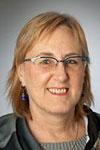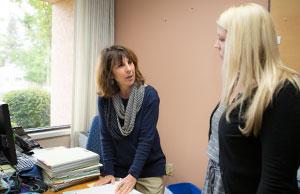
Carla Gordon Levin at the Placer County Adult System of Care (photo by Elisabeth Fall)
Can Psychiatric/Mental Health Nurse Practitioners Fill California’s Provider Gap?
Mid-morning on a weekday, the waiting room for the Placer County Adult System of Care (ASOC) begins to fill. The ASOC provides mental health services and substance abuse treatment services to a rural and suburban stretch of Northern California. Its bulletin boards offer programs for services like stress reduction and problem gambling, urge people to “reduce stigma” and note that there are no injections on Thursday afternoons.
A 40ish woman in a powder-blue hoodie and leggings plops herself next to a man about the same age with neat blond hair and oversized glasses. The two begin discussing the weight gain caused by their meds, until psychiatric/mental health nurse practitioner (PMHNP) Carla Gordon Levin emerges from the back.
A vibrant presence, Levin began working as a mental health nurse after receiving her BSN from UC San Francisco School of Nursing in 1976. Except for a few periods where she worked in community health and taught, she remained in mental health for most of the next 39 years, earning a master’s in 1989 from the School in psychiatric/mental health nursing and – while working as a lead nurse at a large inpatient unit in Woodland – successfully completing the post-master’s Psychiatric/Mental Health Nurse Practitioner certification, in March 2014.
The woman in the hoodie is a new patient, and Levin has barely had time to read her chart at the beginning of a day packed with nine appointments and a weekly clinician conference. Yet after a mere 20-minute session, Levin has to decide how best to help someone who, after arriving from out of state, was hospitalized for three months with bipolar disorder and polysubstance dependence and, since her release, has been off her medications while living in a homeless shelter. Now, as she anticipates a job interview, the woman feels manic and overwhelmed with anxiety and wants to get back on her medications.
Levin explores the possibilities – the woman has many qualifiers about what she can tolerate and, despite Levin’s suspicions, denies using illicit drugs. Levin decides against requiring a toxicology screen, believing it more important at the moment to establish trust. When the woman leaves, Levin does the necessary paperwork, arranges an appointment for the woman to meet with one of the clinic’s RNs in a week, gets a case manager assigned and begins preparing for her next appointment.
A Desperate Need
In the United States, nearly 1 in 5 adults have some form of mental illness, according to the National Institute of Mental Health. The Affordable Care Act (ACA) tries to address this with a requirement that individual and small-group plans include coverage for mental health care that is comparable to that for general medical care, but actual implementation is difficult, given a nationwide shortage of mental health professionals. In California, the federal government has identified 167 mental health professional shortage areas, which, perhaps, is why the California Mental Health Planning Council has suggested that increasing the recruitment and preparation of PMHNPs like Levin as primary mental health providers is one way to address the shortage in county-operated mental health programs and state hospitals. Such programs often are the last resort for patients with severe mental illness.
 Bethany J. Phoenix In the past, psychologists and social workers – less expensive and easier to find – might have been the choice to pick up the slack, but as effective medications for many forms of mental illness have emerged, the need for prescribing clinicians has increased. With psychiatrists in short supply, particularly in traditionally underserved rural and low-income urban settings, PMHNPs – who are licensed to furnish medications – could be an attractive and cost-effective complement to the psychiatrists. Yet due to a confluence of factors – including lack of awareness of the PMHNP role, scope-of-practice regulations, bureaucratic hurdles, tight budgets and too few training slots and programs – PMHNPs are still not widely used.
Bethany J. Phoenix In the past, psychologists and social workers – less expensive and easier to find – might have been the choice to pick up the slack, but as effective medications for many forms of mental illness have emerged, the need for prescribing clinicians has increased. With psychiatrists in short supply, particularly in traditionally underserved rural and low-income urban settings, PMHNPs – who are licensed to furnish medications – could be an attractive and cost-effective complement to the psychiatrists. Yet due to a confluence of factors – including lack of awareness of the PMHNP role, scope-of-practice regulations, bureaucratic hurdles, tight budgets and too few training slots and programs – PMHNPs are still not widely used.
“If you look at public mental health over the past 30 years, there’s been a real erosion of nursing’s presence,” says Bethany J. Phoenix, who coordinates the School’s Psychiatric/Mental Health Nurse Practitioner specialty.
To understand how the state could best mobilize and leverage a PMHNP workforce, Phoenix and Susan Chapman – who directs the Health Policy Nursing specialty in the School’s Department of Social and Behavioral Sciences – are co-leading a study examining the structural, practice and policy opportunities and barriers to the use of PMHNPs in public mental health settings.
The School, however, has not waited for the study results to begin acting. By successfully pursuing a series of grants and creative partnerships, it has established faculty-led behavioral health practices in four county mental health settings, engaged and compensated nonfaculty preceptors to train PMHNP students, secured stipends for PMHNP students and worked closely with local nonprofits to help counties overcome bureaucratic hurdles to hiring NPs.
Why NPs?
“One obvious advantage [of PMHNPs] is that people with severe mental illness also have a high level of chronic medical illness,” says Phoenix. “Nurses of all stripes have a broader view of health.”
 Toni Tullys “Especially in the context of the ACA, there is an enormous advantage to having someone who can do a whole-person assessment and also tend to psychiatric needs,” says Toni Tullys, head of the Department of Behavioral Health Services in Santa Clara County. As a former practicing RN, Tullys views herself as a champion for NPs in mental health.
Toni Tullys “Especially in the context of the ACA, there is an enormous advantage to having someone who can do a whole-person assessment and also tend to psychiatric needs,” says Toni Tullys, head of the Department of Behavioral Health Services in Santa Clara County. As a former practicing RN, Tullys views herself as a champion for NPs in mental health.
Even when solely providing mental health services, NPs bring unique qualities by virtue of their training. Psychiatrist Lawrence Lanes is the medical director for Marin County Mental Health and Substance Use Services, which has used PMHNPs for a number of years, including working with UCSF clinical faculty member Aaron Miller to create a faculty practice serving children, adolescents and their families.
“NPs bring a different perspective that can be useful in working with the clients we have who need a lot of support and interaction,” says Lanes. “Our NPs seem very comfortable with a hands-on approach and a tradition of caring.”
Lanes adds that NPs have been easier to find and, at least in up-front costs, appear to be a less expensive option than psychiatrists, though there may be some hidden costs that health care systems need to account for.
Al Rowlett is CEO of Turning Point Community Programs, a nonprofit that contracts with Placer County to supply mental health providers, including Levin and UCSF faculty member Deborah Johnson, who has established a faculty practice in Placer County for children, adolescents and their families. Rowlett says NPs are also excellent team players in a system that is moving quickly towards team-based care. “They work effectively with psychiatrists – collaborative and complementary. Our experience is that the nurses appreciate the role of physicians, and our physicians have a unique appreciation of NPs; they understand the importance of more prescribers, especially in rural areas.”
The mutual respect and team approach are evident when Levin and Johnson speak of their collaboration with Placer County Chief Psychiatrist and Medical Director of Mental Health Olga Ignatowicz. “Olga and I work closely together,” says Levin. “She has not only been a great teacher, but is really superb at seeing the whole picture, medical and psychiatric.”
Overcoming the Barriers
Given such advantages, it may seem surprising that PMHNPs are not more widely used.
Part of the reason is economic. Though they may be less costly than a psychiatrist, “When you fully load their salary – advanced practice status and benefits – NPs cost more than other nursing positions, so you have to make clear that they do something critical for our population,” says Tullys.
 Kimberly Mayer “Another thing is that policies at the county level can be larger barriers than anticipated,” says Phoenix. “Many of the job descriptions for NPs were written 30 years ago and are aimed at providing primary care – giving immunizations and doing pelvic exams – which is not a good fit for psych NPs.”
Kimberly Mayer “Another thing is that policies at the county level can be larger barriers than anticipated,” says Phoenix. “Many of the job descriptions for NPs were written 30 years ago and are aimed at providing primary care – giving immunizations and doing pelvic exams – which is not a good fit for psych NPs.”
Unfortunately, even something as seemingly simple as rewriting a job description can be a “real challenge because in a public health system you have to reallocate funds to create those positions in HR systems that can’t always move quickly,” says Kimberly Mayer, associate director for Workforce Development at the California Institute for Behavioral Health Solutions (CIBHS). “And those positions have to be created by people who are aware of how to use psych NPs.”
Poorly written job descriptions can have surprisingly long-term consequences, which include not being able to attract the PMHNPs or putting people in positions where it is difficult for them to properly serve their clients.
Part of the solution may be to conduct educational outreach with county mental health directors who don’t have experience with PMHNPs and who may not fully understand NP scope of practice. But existing scope-of-practice restrictions in California can also be a challenge, says Tullys, as a physician or psychiatrist must be willing and available to supervise NPs. She says making clear the unique advantages of an NP – such as how they are particularly well suited to keeping patients with comorbid physical and mental health challenges out of the hospital – can make an enormous difference.
Creative Partnering
 Deborah Johnson Even when counties believe in NPs, they sometimes have to find creative ways to work within the bureaucratic tangles, including turning to partnerships like the one between Placer County and Turning Point.
Deborah Johnson Even when counties believe in NPs, they sometimes have to find creative ways to work within the bureaucratic tangles, including turning to partnerships like the one between Placer County and Turning Point.
Johnson notes that for years Placer County had been relying largely on three- to six-month temporary contracts with psychiatrists, known as locum tenens, to provide mental health services. Frustrated with both the shortage of psychiatrists and the compromises that these arrangements imply in continuity of care, the county began advertising for a full-time PMHNP position.
“But full-time with these types of chronic and complex patients is extremely demanding,” says Johnson; many NPs will look for a position with better working conditions. What ultimately has become a three-way arrangement with UCSF, Placer County and Turning Point has worked out to everyone’s benefit, not least the patients’.
“Working with UCSF to bring in the providers has been incredibly successful,” says Rowlett. “Placer County recognized the role NPs could play and engaged us; we can be more flexible than they can with hours and rate.”
“I think this can be a lesson learned for counties about how to be limber enough to create situations that get them the resources they need to provide the best possible care,” says Johnson.
Mayer agrees that contracted nonprofits can be more nimble and provide needed help. Yet she warns that each county has different systems, including agency contracts for community-based care – and also contracts for individuals who may work alongside county staff. These types of arrangements have their own challenges, which might include everything from tension between county and contract employees to concerns about job security and benefits for the contract employees.
Filling the Pipeline
Even if the positions are there – and both Mayer and Tullys believe they are or will be soon – there are questions of whether existing training programs can expand to meet the need and counties can attract graduates who want to work where they are most needed.
“The jobs tend to be in more rural or underserved areas,” says Mayer. “But students should remember that the public mental health system is an incredible training ground for any clinician because you have the opportunity to work with a range of severely mentally ill clients using a broad variety of modalities, in both outpatient and inpatient settings.”
PMHNP student Megan O’Brien enrolled in the School’s Master’s Entry Program in Nursing (MEPN) after earning her undergraduate degree in psychology at the University of Washington, where she went on to do neuroscience research in a clinical psychology lab. “It got me interested in the physical aspects of mental health, and when I came across the role of the NP in psychiatry, it was exactly what I wanted to do – to bring together the scientific, mental and physical health background,” she says.
In her final year of the MEPN program, she is completing her clinical rotation at Marin County Mental Health and Substance Use Services. The bulk of her time is spent in Marin Youth and Family Services, working with children with moderate to severe mental illness, precepted by either Miller or a child psychiatrist. O’Brien also spends a day a week working with another NP, providing adult outpatient mental health services.
“I’m really fortunate to be at a child and adult site,” she says. “I get to see cases where it’s challenging to formulate a diagnosis and the pharmacology is complex, but I get a lot of support from my preceptors, and we work very much as a team. It’s well-rounded, rigorous training.”
Miller believes that the Marin faculty practice, which serves both suburban and rural residents of the county, “opens up possibilities when our students graduate to work in more rural areas, which is good for Marin and hopefully other counties as well. It also has opened up training opportunities working with children, adolescents and families, which is an area of very high need.”
A Multipronged Effort
The faculty practices – in Placer and Marin counties, as well as at Mills College in Oakland and at UCSF Medical Center in San Francisco – are part of the School’s effort to help fill the provider gap while improving the quality of training for its PMHNP students.
To draw more students to the PMHNP program, two different funding sources provide stipends to enrolled students. One offers a year of funding up to $18,500, with the requirements that the student do her clinical placement in a public mental health setting and a year of payback service in public mental health. The other – a $10,000, one-year stipend – is for students interested in working with children and youth in public mental health settings and does not require payback service.
Finally, the School received a federal training grant to develop curriculum materials for its students, which leverages federal guidelines for the process of screening, brief intervention and referral to treatment – a critical piece of how clinicians work in today’s mental health system.
Their Time Has Come
“NPs may not yet be common behavioral health providers, but they can provide much of what is needed in these settings,” says Tullys. “They are really good at conducting assessments, finding social support and resources and making decisions.”
 Levin and RN Mallory Stafford discuss a patient (photo by Elisabeth Fall). They’re also good at working with and around systems to make sure patients get what they need. “At UCSF, I learned that we were being educated and trained to become agents of change,” says Levin. “That is a concept I have always subscribed to. Over the years, I’ve found myself being the one who wants to do something differently to meet an unmet need.”
Levin and RN Mallory Stafford discuss a patient (photo by Elisabeth Fall). They’re also good at working with and around systems to make sure patients get what they need. “At UCSF, I learned that we were being educated and trained to become agents of change,” says Levin. “That is a concept I have always subscribed to. Over the years, I’ve found myself being the one who wants to do something differently to meet an unmet need.”
Watching Levin at work in the ASOC illustrates the concept. When she goes to call in her second patient of the morning, she finds him outside, seated on a bench, smoking. She speaks to him briefly out there before bringing him into her office. After the appointment, which revealed someone who also has been off his meds and is clearly delusional, Levin strategizes with RN Mallory Stafford about how to get the man back on his medications that day and then how to best follow up so he continues to make his clinic appointments.
“You know, his mother is in the parking lot,” Levin says. “Why don’t we talk to her and make sure she knows we expect to see him in two weeks?”
Patient stories in this article are composites, and any resemblance to an actual individual is unintentional.



